Excerpted from Will Richardson's new TED Book Why School: How Education Must Change When Learning and Information Are Everywhere. Richardson offers provocative alternatives to the existing education system, questioning everything from standardized assessments to the role of the teacher. In this chapter, "Real Work for Real Audiences," Richardson envisions students creating work that is relevant and useful in the world outside school.
By Will Richardson
So what if we were to say that, starting this year, even with our children in K– 5, at least half of the time they spend on schoolwork must be on stuff that can’t end up in a folder we put away? That the reason they’re doing their schoolwork isn’t just for a grade or for it to be pinned up in the hallway? It should be because their work is something they create on their own, or with others, that has real value in the real world.
I’m not even necessarily talking about doing something with technology. (Let’s face it, though: Paper is a 20th-century staple that has severely limited potential, compared to digital spaces.) There’s lots of creating our kids can do with traditional tools that can serve a real audience. Publishing books, putting on plays, and doing community service are just a few examples.
But what if we got a little crazy and added some technology into the mix? We could tell our kids, “You know, in addition to taking that test on the Vietnam War, we want you to go and interview some veterans, then collect those stories into a series of podcasts that people all over the world could listen to and learn from.”



